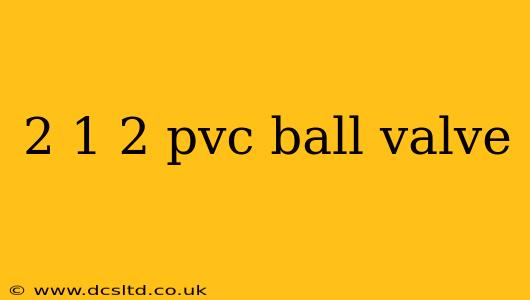Understanding 2 1/2" PVC Ball Valves: A Comprehensive Guide
Choosing the right valve for your plumbing or industrial application is crucial. A 2 1/2" PVC ball valve is a common choice for many projects, offering a simple, reliable, and cost-effective solution for controlling the flow of liquids or gases in PVC piping systems. This comprehensive guide will explore everything you need to know about these valves, addressing common questions and providing valuable insights.
What is a 2 1/2" PVC Ball Valve?
A 2 1/2" PVC ball valve is a type of valve that uses a rotating spherical ball to control the flow of fluids. The "2 1/2"" refers to the nominal pipe size (NPS), indicating the valve's internal diameter. PVC, or polyvinyl chloride, is a durable, lightweight, and corrosion-resistant plastic commonly used in plumbing and various industrial applications. The ball inside the valve has a hole bored through its center. Rotating the ball 90 degrees aligns the hole with the pipe, allowing full flow; rotating it 90 degrees further shuts off the flow completely. This simple on/off mechanism makes them easy to operate and maintain.
What are the different types of 2 1/2" PVC ball valves?
Several variations exist within the 2 1/2" PVC ball valve category, each designed for specific applications and needs:
- Full-Port Ball Valves: These offer a completely unobstructed flow path through the valve, minimizing pressure drop and maximizing flow efficiency. They are ideal for applications requiring high flow rates.
- Reduced-Port Ball Valves: These have a smaller internal diameter than the nominal pipe size, resulting in a more compact design. They are suitable for applications where space is limited, although they may cause a slight increase in pressure drop.
- Three-Way Ball Valves: These valves have three ports, allowing for diverting flow in different directions. They are useful for mixing or diverting fluids.
- Manual vs. Automatic: Most 2 1/2" PVC ball valves are manually operated using a lever handle, but automated versions are also available for use in systems requiring remote or automated control, often incorporating actuators.
What are the advantages of using a 2 1/2" PVC ball valve?
PVC ball valves offer several significant advantages:
- Corrosion Resistance: PVC is highly resistant to corrosion from many chemicals and substances, making it ideal for handling various fluids.
- Lightweight: PVC is significantly lighter than metal valves, making installation and handling easier.
- Cost-Effective: PVC ball valves are generally less expensive than valves made from other materials like metal.
- Easy Installation and Maintenance: Their simple design makes them easy to install and maintain, requiring minimal specialized tools.
- Long Lifespan: With proper use and maintenance, PVC ball valves can provide years of reliable service.
What are the applications of a 2 1/2" PVC ball valve?
2 1/2" PVC ball valves find applications in a wide range of settings, including:
- Irrigation Systems: Controlling water flow in agricultural settings.
- Industrial Processes: Handling various fluids in chemical processing plants and other industrial settings.
- Plumbing Systems: Controlling water flow in residential and commercial buildings.
- Water Treatment Plants: Managing water flow in treatment processes.
- Chemical Handling: Suitable for many non-corrosive chemicals.
How do I choose the right 2 1/2" PVC ball valve?
Selecting the appropriate valve involves considering several factors:
- Pressure Rating: Ensure the valve's pressure rating exceeds the maximum operating pressure of your system.
- Temperature Rating: The valve must be rated for the temperature range of the fluids it will handle.
- Type (Full-port, Reduced-port, Three-way): Choose the valve type that best suits your flow requirements and space constraints.
- End Connections: Ensure the valve's end connections (e.g., threaded, socket, flanged) are compatible with your piping system.
- Material Compatibility: Verify that the PVC material is compatible with the fluids being handled.
How do I install a 2 1/2" PVC ball valve?
Installing a 2 1/2" PVC ball valve is relatively straightforward, but proper techniques are crucial to ensure a leak-free and reliable connection. Consult the manufacturer's instructions for specific guidance, but generally, this involves using appropriate PVC cement and ensuring proper alignment of the pipe and valve. Always double-check all connections before pressurizing the system.
This comprehensive guide provides a detailed overview of 2 1/2" PVC ball valves. Remember to always prioritize safety and consult with a qualified professional if you're unsure about any aspect of selection, installation, or maintenance. Proper selection and installation are key to ensuring the longevity and reliability of your system.
